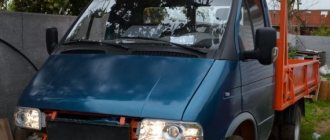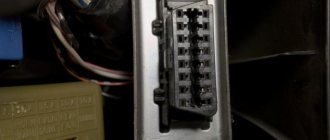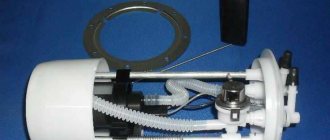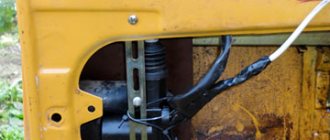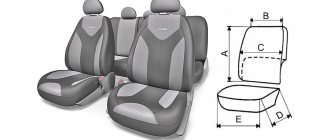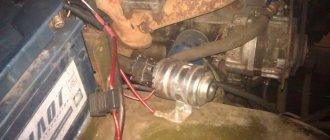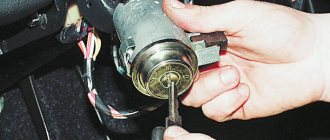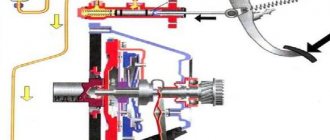Any motorist will say that the GAZ 3110 steering mechanism is one of the most important components of the car. Without this it is impossible to drive a car. If there is a problem with the steering mechanism assembly, then operating the GAZ-3110 is strictly prohibited. Even if there is play in the steering wheel, you need to pay attention to it. When a backlash is detected, the driver first goes to a technical inspection station to diagnose the Volga.
Parts for repair of the steering mechanism Gas 3110
When the cause is identified, there are 2 options for solving it. The first is to leave the car to professionals who will make the steering mechanism assembly for a fee, or figure it out yourself and eliminate the cause of the breakdown. In order to know how to fix the problem, you need to have an idea of what the GAZ-3110 steering system consists of:
Device diagram and steering design
- Steering wheel.
- Column.
- Steering gear.
- Hydraulic booster.
- Drive unit.
It would also be very good to consider, or better yet, learn the diagram of what is attached to what and what it looks like.
Checking the mechanism
If the driver notices any problems with the steering mechanism. It will be seen and heard. The steering wheel may shake and there may be a drumming sound. When turning, the steering wheel will “wedge” or “knock out”.
Drawing with the names of the elements of the steering column GAZ 3110
You can check the node yourself. To do this you need:
- Put the GAZ-3110 on the handbrake.
- Place supports under the rear wheels.
- Loosen the wheel on the left at the front.
- The front of the car should be raised and placed on supports.
- Remove the wheel.
- After this, remove the protective mudguard.
- In the Volga 3110 interior, completely disconnect the assembly shaft from the mechanism below.
- It is required to mark the position of the control shaft and bipod.
- Remove the bipod from the shaft.
- After removing the bolts, remove the mechanism.
The design of the steering mechanism on the GAZ-3110
Any motorist will say that the GAZ 3110 steering mechanism is one of the most important components of the car. Without this it is impossible to drive a car. If there is a problem with the steering mechanism assembly, then operating the GAZ-3110 is strictly prohibited. Even if there is play in the steering wheel, you need to pay attention to it. When a backlash is detected, the driver first goes to a technical inspection station to diagnose the Volga.
Parts for repair of the steering mechanism Gas 3110
When the cause is identified, there are 2 options for solving it. The first is to leave the car to professionals who will make the steering mechanism assembly for a fee, or figure it out yourself and eliminate the cause of the breakdown. In order to know how to fix the problem, you need to have an idea of what the GAZ-3110 steering system consists of:
Damage analysis
To identify a malfunction, you need to check the crankcase. If there is a crack or chip on it, then it cannot be repaired; you need a new one.
The bushings look worn out. They also need to be replaced. You can find the crankcase assembly at points of sale of parts.
Worm and roller - if deformation is detected - replace. The bearing should be lubricated and without obvious flaws.
Steering columns removed from the car
If oil leaks occur from time to time, gaskets and seals need to be replaced. Reassembly is carried out in the reverse order, according to the marks made during disassembly.
Adjusting the steering gear
Place the front wheels level. You need to place the screwdriver bottom on the steering wheel at the point at the top. Rotate the steering wheel until resistance appears. The wheels are in their original position. When finding a backlash, you need to mark the points.
If the play is 17 mm or more, you need to find this reason. If it is less than the specified distance, then the gap between the roller and the worm is simply adjusted. Remove the front wheel on the left. Using a 30mm wrench, unscrew the cap nut and remove the washer from there. Take a 12mm hex key and unscrew the clockwise adjustment screw a little. Thus, check the play on the steering wheel until it is less than 17 mm, reassemble in the reverse order.
If in the Volga, when turning, the steering wheel returns to its original position, you need to measure the play again.
When a crunching sound occurs in the steering wheel when driving on a bad road surface, or when driving over speed bumps. This occurs at low speeds or at high steering angles. A call to a car maintenance service is required. During diagnostics, a problem related to the steering gear may be identified.
This is what the gas 3110 steering gear looks like
If you have enough money, you can leave the car in a repair shop, where the experts in their field will fix this problem by replacing it with a new one. But, if you don’t have trust or money, you can try to repair the steering gear yourself. This requires, first of all, compliance with safety rules. The presence of a pit in the garage, knowledge of the steering mechanism of the 31st Volga and all the necessary keys for disassembling and reassembling the mechanism.
The process of installing the steering column on gas 3110
Refinement of the GAZ 3110 power steering system
The car came stock with power steering... well, it would be better if it wasn’t there at all. The power steering gearbox was installed in the very first production of ShNKF 453465.100.
There were problems with the power steering system from the first day of owning the car... the pump was changed 3 times... the power steering was rebuilt 1 time... looking ahead, I’ll say that this gearbox was not completed before replacement for only 2 weeks and began to leak
There was an idea to buy this power steering kit from Avtodetalservis avtodetal.com/index.php?section=282 Here is a review from a person who bought and installed it for himself www.drive2.ru/cars/gaz/31...376151945221/#replieslist But I have to buy it like this and it failed... if only because of its cost in Ukraine. 5000 hryvnia is not a little, and that’s for Russian parts...
Well, since I couldn’t buy everything at once... I decided to take a more time-consuming and correct path.
I collected a few details like this:
1. I bought a used Volga 31105 power steering gearbox ShNKF 453461.103 link to technical specifications www.agu.by/index.php?module=view_id&vid=1299
2. Power steering pump bracket from the Avtodetalservice kit
3. Power steering pump from a Chevrolet Niva car, part number according to catalog 2123-3407012.
4. I bought a copper tube with a diameter of 13 mm, from which I bent an oil cooler for the power steering system
5. I turned a pulley of the required diameter, since it was not possible to find a ready-made one.
I also additionally bought hoses, metal corrugation, copper washers, adapters, clamps...
The purchased used power steering gearbox from the 105th Volga was sent for modification to the craftsmen at the hydrolab in Moscow (www.gidrolab.ru/price1.shtml). Such modification cost 3,500 rubles. rub. In principle, I have no complaints about them yet, but these guys did not return the bipod and driveshaft that were on the gearbox...
Came like this from Moscow
Stage No. 1 Installation of the power steering radiator: Radiator made of 13mm copper tube. is placed in place of the oil cooler. I bought good quality hoses and laid them in an iron corrugation so that the hoses did not fray or bend. The radiator is placed in the drain line from the gearbox to the expansion tank.
The radiator is fixed, the tubes are connected.
Stage No. 2 Preparing the pump for installation: Here I was faced with a choice for a long time: whether to take it from a Volkswagen, BMW, Audi or Chevrolet Niva
On the left is a pump from an Audi A6 on the right from a Chevrolet Niva... in this photo you can clearly see that they are very similar. There are differences in the angles of the hoses...
But when choosing a pump I encountered a number of problems. Firstly, the stock pressure of the Belarusian pump is 90 bar, for Audi and BMW it is 120 bar, for Niva it is 104 bar. I did not dare to take a pump with such a high operating pressure... Secondly, the cost of a good pump exceeds 3000 UAH, Chinese analogues and other fakes are no better than the Russian pump, but more expensive... In the end, I settled on a pump from a Chevrolet Niva, part number according to the catalog 2123-3407012
To install this pump on a 406 motor, you need a bracket like the one in the second photo from the top.
The Chevrolet Niva pump is sold without a pulley. And the stock pulley from this car will not suit us, because it is larger in diameter and fits a 5-ribbed belt. You need to order a turner to turn the pulley. Couldn't find a finished one. I think that no one will sell it separately during analysis... new ones, judging by Exist, have prices starting from 300 UAH. The work on making the pulley + materials cost 190 UAH.
And one more problem... The bolt that screws the high-pressure tube to the pump in the drain is 10 mm, and in the pump there is a hole for a 12 mm bolt. An adapter from one thread to another is needed... I managed to find one on the market... but the thing is very rare...
Pump assembly with bracket, pulley and adapter... ready-made design for installation on internal combustion engines
Stage No. 3 Removing the gearbox and bipod from the gearbox, more details here gazclub.ru/faq/?mess_id=450
When I removed the old gearbox... I need to remove the bipod from it, which needs to be installed on the new gearbox... those who have ever done this will understand that this procedure is more complicated than the process of removing the gearbox itself.
Summing up
As a result, we can say that the steering unit in a car is the main component of the entire mechanism. Do not postpone repair work and diagnostics if any deviations appear. At the slightest incomprehensible sound or vibration, you need to go to a service station and get a diagnosis done.
Installation of a steering column on a Gas car
Because this barely audible sound while the car is moving can turn into a big problem, especially if the Volga is driving at high speed along the highway.
Elimination of power steering pump defects
The faults have been found, now we begin to eliminate them.
Read more: View off-road tractors
We will need rags, white alcohol, sandpaper with grit P1000/P1500/P2000, a triangular needle file, a drill bit of Ø12mm (or more) and an electric drill. With the shaft everything is much simpler, you will need P1500 sandpaper and with it we begin to clean all the edges of the grooves on the shaft (we clean the outer and side ones on both sides) in all possible ways. We work without fanaticism, the main task is to remove only sharp burrs.
For one thing, you can immediately polish both sides of the shaft a little on a flat surface, it is advisable to use P2000 sandpaper.
Next, we need to check the result of our work, we check visually and by touch, everything is perfectly smooth and does not cling.
The most difficult thing will be with the surface of the cylinder; personally, I couldn’t figure out anything simpler than how to make a spherical grinder from sandpaper, a drill and a thick drill (F12). To begin with, we take the P1000 sandpaper and a drill bit that can be inserted into the drill.
Next, you need to tightly screw the skin against the rotation of the drill, two or three turns, there should be no gaps.
Holding the tightly twisted structure, it needs to be inserted into the drill (the skin should also be clamped).
Afterwards, using the most convenient methods for you, we carefully begin to grind the cylinder, you need to grind evenly, press the cylinder tightly and move it relative to the axis of rotation (at maximum speed). As we eat the skins, we change them, eventually we reach the smallest skin P2000.
The desired result is obtained,
Now everything needs to be thoroughly wiped with a trail of white alcohol. The shaft itself with the blades can be rinsed in it.
After we begin the assembly, everything is put in the reverse order of removal.
Repairing power steering is a complex task and painstaking work. The article is intended for those car enthusiasts who are familiar with the structure of the main car systems.

